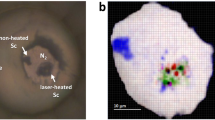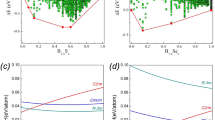Abstract
DURING the course of investigations of solid solutions involving van der Waals solids it was found that sulphur and tin tetraiodide combine readily in carbon disulphide or benzene solution forming a stable compound, the formula of which was determined as SnI4.2S8. The substance is orange in colour, has a measured density of 2.85 g/c.c., and melts at 101° C. It crystallizes either as orthorhombic pyramids by evaporation of a carbon disulphide solution or as third-order prisms by cooling of a saturated benzene solution, leading to the assignment of the point group mm2. (A metastable monoclinic modification of density = 2.80 g/c.c. was also observed during rapid cooling of benzene solutions.)
This is a preview of subscription content, access via your institution
Access options
Subscribe to this journal
Receive 51 print issues and online access
$199.00 per year
only $3.90 per issue
Buy this article
- Purchase on Springer Link
- Instant access to full article PDF
Prices may be subject to local taxes which are calculated during checkout
Similar content being viewed by others
References
Dickinson, R. G., J. Amer. Chem. Soc., 45, 958 (1923).
Warren, B. E., and Burwell, J. T., J. Chem. Phys., 3, 6 (1935).
Hawes, L. L., Amer. Min., 45, 1285 (1960).
Hassel, O., and Romming, Chr., Quart. Rev., 16, 1 (1962).
Author information
Authors and Affiliations
Rights and permissions
About this article
Cite this article
HAWES, L. A Semi-bonded Compound in the Series SnI4–S8. Nature 196, 766–767 (1962). https://doi.org/10.1038/196766a0
Issue Date:
DOI: https://doi.org/10.1038/196766a0
This article is cited by
Comments
By submitting a comment you agree to abide by our Terms and Community Guidelines. If you find something abusive or that does not comply with our terms or guidelines please flag it as inappropriate.



